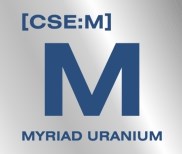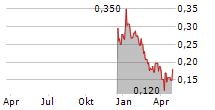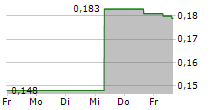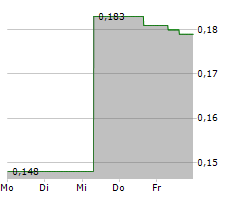Vancouver, British Columbia--(Newsfile Corp. - October 1, 2025) - Myriad Uranium Corp. (CSE: M) (OTCQB: MYRUF) (FSE: C3Q) ("Myriad" or the "Company") is pleased to announce that a comprehensive report relating to a large-scale study of Copper Mountain by Bendix Field Engineering Corporation (Bendix) for the U.S. Department of Energy (DOE) from 1982 has been obtained, enabling the Company to release the study's conclusions regarding Copper Mountain's potential uranium endowment.
Previously, the Company only had access to a summary companion document titled Copper Mountain, Wyoming, Intermediate-Grade Uranium Resource Assessment Project Final Report (November 1982)1. However, a comprehensive report titled An Exploration Systems Approach to the Copper Mountain Area Uranium Projects, Wyoming (September 1982)2, comprising over 600 pages of detailed data analysis and interpretation, has now been obtained. This report provides the underlying technical information and basis for the assessment that followed. Its authors had access to the entirety of Union Pacific's vast data set, the product of C$118 million (current dollars) in exploration and development spending during the 1970s. Bendix also generated a considerable amount of their own data for the study. For these reasons, the information is considered relevant and reliable and will be used by Myriad to generate its own exploration targets for project expansion.
Key conclusions from the study include:
A "Control Area" at Copper Mountain, centred on the Canning Deposit, was estimated to have a potential mineral endowment of ~245 million pounds uranium down to a depth of 600 feet in the intermediate grade range of 100 - 500 ppm eU3O8. Myriad and its partner, Rush Rare Metals Corp., hold approximately 70% of this Control Area, and an even higher percentage of the historic boreholes drilled in this area.
A larger "Assessment Area" was estimated to have a potential mineral endowment of ~655 million pounds uranium, also to a depth of 600 feet. Myriad and Rush hold approximately 29% of this area.
Several probable target areas for extensive intermediate-grade uranium deposits were identified by the study through structural scoring of the Assessment Area. These include locations within the Control Area that previously lacked drill-hole data, and Myriad is now aware of.
Note: These estimates are historical in nature and do not represent current mineral resource, reserve or exploration target estimates under the category definitions provided by NI 43-101. They represent potential mineral endowments that would require exploration work and drilling to verify. The key assumptions, parameters, and methods used to prepare the historical estimates are described in this document. There are no more recent estimates of this type. A qualified person has not done sufficient work to classify the historical estimates as current mineral resources or mineral reserves. Myriad and Rush are not treating the historical estimates as current mineral resources or mineral reserves.
1Citation: Madson, M. E., Ludlam, J. R., Fukui, L. M., & Bendix Field Engineering Corp., Grand Junction, CO (USA). Grand Junction Operations. (1982). Copper Mountain, Wyoming, intermediate-grade uranium resource assessment project. Final report. National Uranium Resource Evaluation.
2Citation: Sayala, Dasharatham; Lindgren, J. & Babcock, L. An Exploration Systems Approach to the Copper Mountain Area Uranium Deposits, Central Wyoming, report, September 1982; University of North Texas Libraries, UNT Digital Library, https://digital.library.unt.edu; crediting UNT Libraries Government Documents Department.
Myriad's CEO Thomas Lamb commented: "The conclusions of the 1982 studies are exciting to us, as we have always thought the Copper Mountain district is underexplored. The core area of Copper Mountain has a potential uranium endowment of ~245 Mlbs down to 600 feet. We hold about 70% of this area and a higher percentage of its boreholes. The Report has also identified potential additional targets across our acreage that we were not previously aware of. Operators at the time, such as Union Pacific and Anaconda, barely scratched the surface outside of the known historic resource areas and this work will really help us to expand our targeting in a meaningful way. Furthermore, the strong potential of the district is highlighted by the occurrence of high-grades from sampling, which we've just learned about in this newly obtained report.
"A potential new dimension to Copper Mountain exists below the "hard deck" of 600 feet. This depth was the general limit for drilling and feasibility studies conducted by Union Pacific in the 1970s. Our 2024 drilling campaign and subsequent assays yielded uranium findings below the hard deck, including at 1,495 feet below Canning and at various other depths. These intercepts, and Anaconda's drilling at Railroad (an area acquired earlier this year) which had notable deep intercepts, hint at the potential for unconformity mineralization related to thrust faults under Copper Mountain. This is a theory that was considered by Anaconda and Union Pacific and a series of experts in subsequent decades, but was not fully tested.
"Back to the Bendix study. It's important to recognise that its authors had the entirety of the Union Pacific data available to them. That data was the product of C$118 million (today's dollars) spent drilling 2,000 boreholes, identifying 7 deposits and many prospects (hopefully deposits-in-waiting), and planning a large-scale mine. Bendix also conducted extensive work themselves, which was supplemental to Union's. We have just begun integrating all of this new data into our systems and we believe it will lead to great things. As our chief geologist George van der Walt put it to me the other day: 'There is a huge amount of uranium in the neighborhood and this information will help us to vector in on it.'"
Background and Purpose
In September and December 1982, Bendix Field Engineering Corporation (Bendix), contracted to the U.S. Department of Energy (DOE), released two reports relating to the Copper Mountain project. These were:
An Exploration Systems Approach to the Copper Mountain Area Uranium Deposits, Central Wyoming (September 1982).
Copper Mountain, Wyoming, Intermediate-Grade Uranium Resource Assessment Project Final Report (November 1982).
The combined reports span at least 700 pages, including appendices, and cover about 2.5 man-years that were used in literature review, field examinations, data compilation, geologic interpretation, and final report preparation. The multi-disciplinary studies were completed during the time that Rocky Mountain Energy Corporation, a subsidiary of Union Pacific, was actively exploring in the district, and who provided property access and critical data, records, and pertinent materials on the project area.
The studies were conducted as part of the Uranium Halo Identification Project (Halo Project), which was part of a larger program called the National Uranium Resources Evaluation (NURE). The objectives of the Halo Project were to 1) characterize specific deposits, 2) develop or improve genetic models, and 3) develop and evaluate cost-effective exploration methods for deposits in specific geologic environments. In particular, the main objective of the second report was to derive mineral endowment estimates by presenting the following information:
A description of the data and methodology used in the mineral endowment estimates.
An explanation of the geological conditions responsible for the mineralization.
Estimates of the potential mineral endowment based on geologic interpretation and industry-supplied borehole data.
The key outcomes of the study are summarized here and will form the basis of exploration targets to be developed at numerous locations, outside of the known historical estimate areas, which will in turn inform Myriad's strategy for developing these targets.
Control and Assessment Areas
Uranium mineralisation at Copper Mountain occurs in two distinct geologic environments:
Fracture-controlled uranium mineralisation hosted in Precambrian/Archaean-aged granite, syenite, isolated occurrences along the margins of diabase dikes and in association with meta-sediment inclusions in granite; and
As disseminations in coarse-grained sandstones and coatings on cobbles and boulders in the Eocene/Tertiary-aged Teepee Trail Formation (Wagon Bed Group) sediments, such as at the Arrowhead (Little Mo) mine and other localities.
Uranium mineralisation is thought to have resulted through supergene and hydrothermal enrichment processes. In both cases, the source of the uranium is thought to be the granites of the Owl Creek Mountains.
The Canning deposit, where Myriad completed verification drilling in November 2024, and nearby deposits with known historical estimates was selected as the primary research location (Control Area) for the studies. According to Bendix, the Control Area was a 12,000 ft (3,658 m) north-south, 16,000 ft (4,877 m) east-west rectangle (17.8 km2) that has a high density of surface and subsurface geologic information. It included the Canning, Fuller, Arrowhead, Allard-Mint, Last Hope, Hesitation, and Gem mineralized areas.
The district Assessment Area, to which the data and methodology of the Control Area was applied to arrive at a district scale estimate, is an area of approximately 40 square miles (103 km2) of favourable host rock. The area is defined geologically on the northern boundary by the northern limit of the collapsed toe portion of the Owl Creek uplift, on the southern boundary corresponding to the Cedar Ridge Fault, on the eastern boundary along or near the western boundary edge of a large remnant of Palaeozoic sedimentary rocks that wrap around the eastern nose of the Owl Creek Uplift, and on the western boundary the inferred western edge of the quartz monzonite of the Canning stock. Myriad currently holds approximately 70% of the Control Area and approximately 29% of the overall Assessment Area.
Detailed subsurface geologic information in the Control Area is a result of close-spaced exploration drilling. DOE provided (with Union Pacific's permission) data for 1,193 mineralized boreholes within the Control Area boundary. Bendix also collected its own geological, geochemical (including drilling) and geophysical data for the assessment. This high-confidence area was used for geologic modelling and structural interpretations essential to the assessment.
Methodology
Bendix relied on a vast amount of information for their assessment. This included detailed geological studies (general geology, tectono-depositional analysis, structure and metallogeny), surface geochemical studies (lithogeochemical, soil and stream surveys), subsurface geochemical studies (drilling, spectral radiometric probing and core geochemistry), geophysics (radiometric, magnetic and electrical methods) and emanometric (helium and radon) studies. The information was a combination of data provided by Union Pacific and data collected by Bendix.
The data was used to develop a genetic model for uranium mineralization in the Precambrian and Eocene sedimentary host rock environments, and to develop a structural scoring system in the high-confidence control area to establish the basis for estimations of uranium mineralization endowment in the total Assessment Area. The model ultimately relied on the relationship between structure and uranium mineralization, which is the primary style of mineralization control at Copper Mountain. The scoring system developed for structural favourability was based on the following parameters and their potential contribution to structural preparation: 1) the presence of a graben(s); 2) the presence of a major east-west-trending fault zone(s); 3) the presence of fault intersections; 4) the presence of variously oriented subsidiary faults; and 5) positioning along a known or inferred favourable structural trend. The scoring system was applied across the Control Area and compared with known deposit locations.
Key Outcomes
The results of the assessment and the structural scoring in the Control Area demonstrated the importance of structural preparation in the formation of uranium deposits in the Canning Stock. It also delineated potential target areas where drill-hole data are lacking. With these outcomes the key conclusions that were drawn from the study were as follows:
- The maximum structural preparation in the Assessment Area is associated with grabens, fault intersections, and numerous subsidiary faults and fractures. The highest-grade uranium occurs along major east-west-trending faults that bound the grabens.
- Known deposits scored highly in the Control Area, compared to areas that were tested and did not produce promising results.
- Several probable target areas for extensive intermediate-grade uranium (100 - 500 ppm eU3O8) deposits were identified by structural scoring of the Assessment Area, including locales in the control area that lacked drill-hole data.
- The potential mineral endowment in the sediments of the Tepee Trail Formation (Wagon Bed Group) of the Control Area was estimated at approximately 6,700 tons (~13.4 Mlbs) eU3O8, and in the total Assessment Area was estimated at approximately 24,000 tons (~48 Mlbs) eU3O8.
- The estimated mineral endowment in the Precambrian granites of the Control Area was estimated at approximately 116,000 tons (~232 Mlbs) eU3O8, and in the total Assessment Area was estimated at approximately 300,000 tons (~608 Mlbs) eU3O8.
- This put the total estimated potential mineral endowment at ~245 Mlbs eU3O8 in the Control Area and ~655 Mlbs eU3O8 in the greater Assessment Area.
Note: These estimates are historical in nature and do not represent current mineral resource, reserve or exploration target estimates under the category definitions provided by NI 43-101. They represent potential mineral endowments that would require exploration work and drilling to verify. The key assumptions, parameters, and methods used to prepare the historical estimates are described in this document. There are no more recent estimates of this type. A qualified person has not done sufficient work to classify the historical estimates as current mineral resources or mineral reserves. Myriad and Rush are not treating the historical estimates as current mineral resources or mineral reserves.
While it is understood that the structural classification of the area is not a guarantee of finding mineralization, the structural scoring of the Control Area successfully delineated known uranium deposits, extended favourable trends related to the known deposits, and delineated potential target areas for additional uranium deposits.
Planned Activity
The detailed nature of the work done by Bendix, in conjunction with Union Pacific, provides a solid foundation for the identification of exploration targets in the Copper Mountain district. Myriad intends to use the results of these studies, together with the other historic information in its possession, to develop an enhanced set of exploration targets for the Copper Mountain project area. The results of this assessment and its iterations will be presented in future disclosure by Myriad and will inform the basis of the Company's strategy for exploration and development going forward.
Qualified Person and Data Verification
The scientific or technical information in this news release respecting the Company's Copper Mountain Project has been reviewed and approved by George van der Walt, MSc., Pr.Sci.Nat., FGSSA, Myriad's consulting geologist and a Qualified Person as defined in National Instrument 43-101 - Standards of Disclosure for Mineral Projects. While the content of the reports is considered to be relevant and reliable, the underlying data, such as original drill logs, sampling, analytical and test data certificates, quality assurance and quality control, is not available for verification. Further work, such as drilling and sampling, will be required to verify or create supplementary information to support the underlying assumptions and conclusions.
About Myriad Uranium Corp.
Myriad Uranium Corp. is a uranium exploration company with an earnable 75% interest in the Copper Mountain Uranium Project in Wyoming, USA. Copper Mountain hosts several known uranium deposits and historic uranium mines, including the Arrowhead Mine which produced 500,000 lbs of U3O8. Copper Mountain saw extensive drilling and development by Union Pacific during the late 1970s including the development of a mine plan to fuel a planned fleet of California Edison reactors. Operations ceased in 1980 before mining could commence due to falling uranium prices. Approximately 2,000 boreholes have been drilled at Copper Mountain and the project area has significant exploration upside. Union Pacific is estimated to have spent C$118 million (2024 dollars) exploring and developing Copper Mountain, generating significant historical resource estimates. The Company also recently acquired, subject to completing a geophysical survey this year, a 100% interest in the Red Basin Uranium Project in New Mexico, which has extensive near-surface uranium mineralisation and significant upside potential. Our Crux Investor overview page including recent interviews can be viewed here. The Company's presentation can be viewed here . News releases regarding historical drilling can be viewed here and here. The final news release regarding chemical assays of 2024 Copper Mountain drilling can be viewed here.
Myriad also has a 50% interest in the Millen Mountain Property in Nova Scotia, Canada, with the other 50% held by Probe Gold Inc. For further information, please refer to Myriad's disclosure record on SEDAR+ (www.sedarplus.ca), contact Myriad by telephone at +1.604.418.2877, or refer to Myriad's website at www.myriaduranium.com.
Myriad Contacts:
Thomas Lamb
President and CEO
tlamb@myriaduranium.com
Forward-Looking Statements
This news release contains "forward-looking information" that is based on the Company's current expectations, estimates, forecasts and projections. This forward-looking information includes, among other things, the Company's business, plans, outlook and business strategy. The words "may", "would", "could", "should", "will", "likely", "expect," "anticipate," "intend", "estimate", "plan", "forecast", "project" and "believe" or other similar words and phrases are intended to identify forward-looking information. The reader is cautioned that assumptions used in the preparation of any forward-looking information may prove to be incorrect, including with respect to the Company's business plans respecting the exploration and development of the Company's mineral properties, the proposed work program on the Company's mineral properties and the potential and economic viability of the Company's mineral properties. Forward-looking information is subject to known and unknown risks, uncertainties and other factors that may cause the Company's actual results, level of activity, performance or achievements to be materially different from those expressed or implied by such forward-looking information. Such factors include, but are not limited to: changes in economic conditions or financial markets; increases in costs; litigation; legislative, environmental and other judicial, regulatory, political and competitive developments; and technological or operational difficulties. This list is not exhaustive of the factors that may affect our forward-looking information. These and other factors should be considered carefully, and readers should not place undue reliance on such forward-looking information. The Company does not intend, and expressly disclaims any intention or obligation to, update or revise any forward-looking information whether as a result of new information, future events or otherwise, except as required by applicable law.
The CSE has not reviewed, approved or disapproved the contents of this news release.

To view the source version of this press release, please visit https://www.newsfilecorp.com/release/268558
SOURCE: Myriad Uranium Corp.


